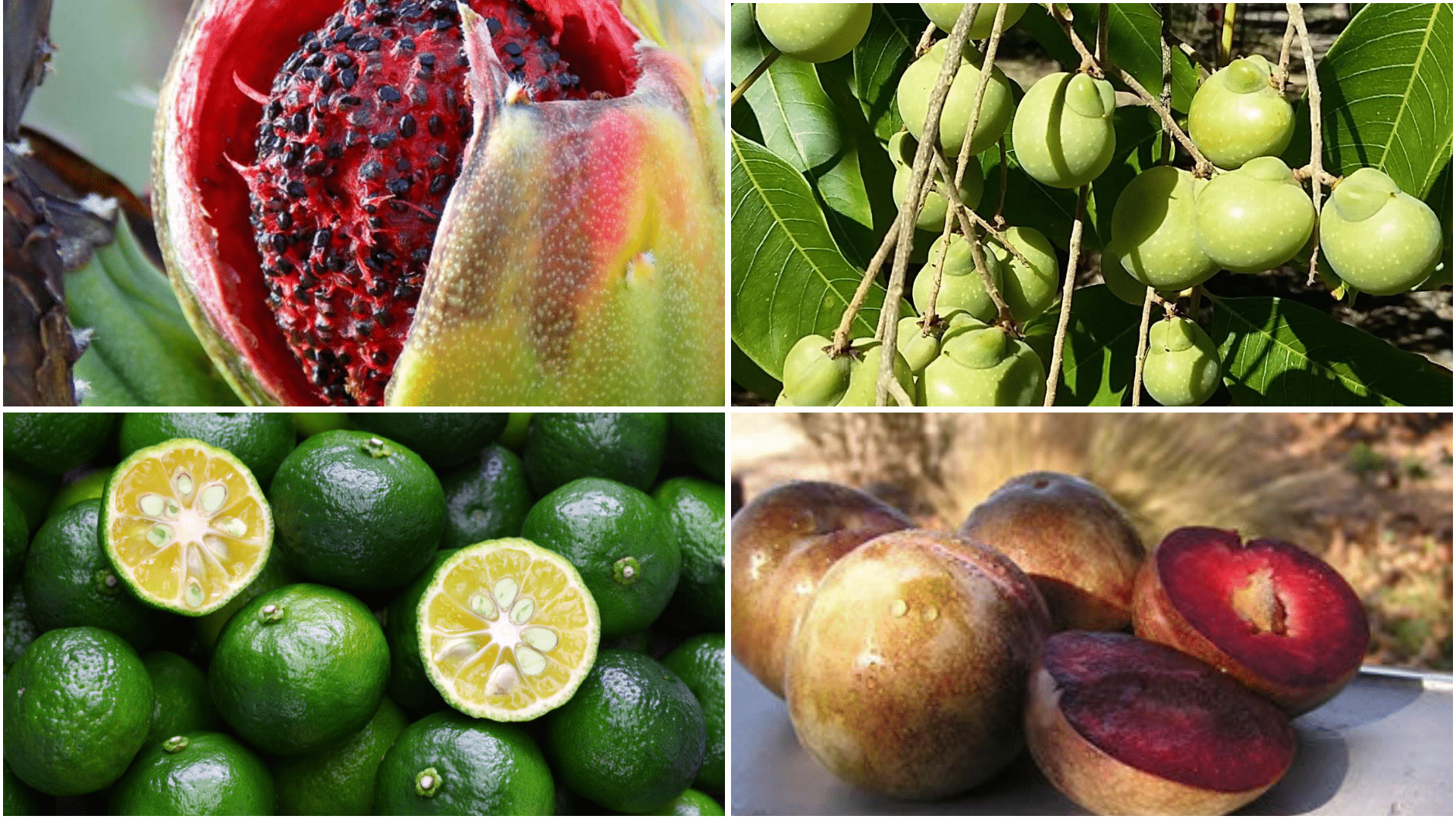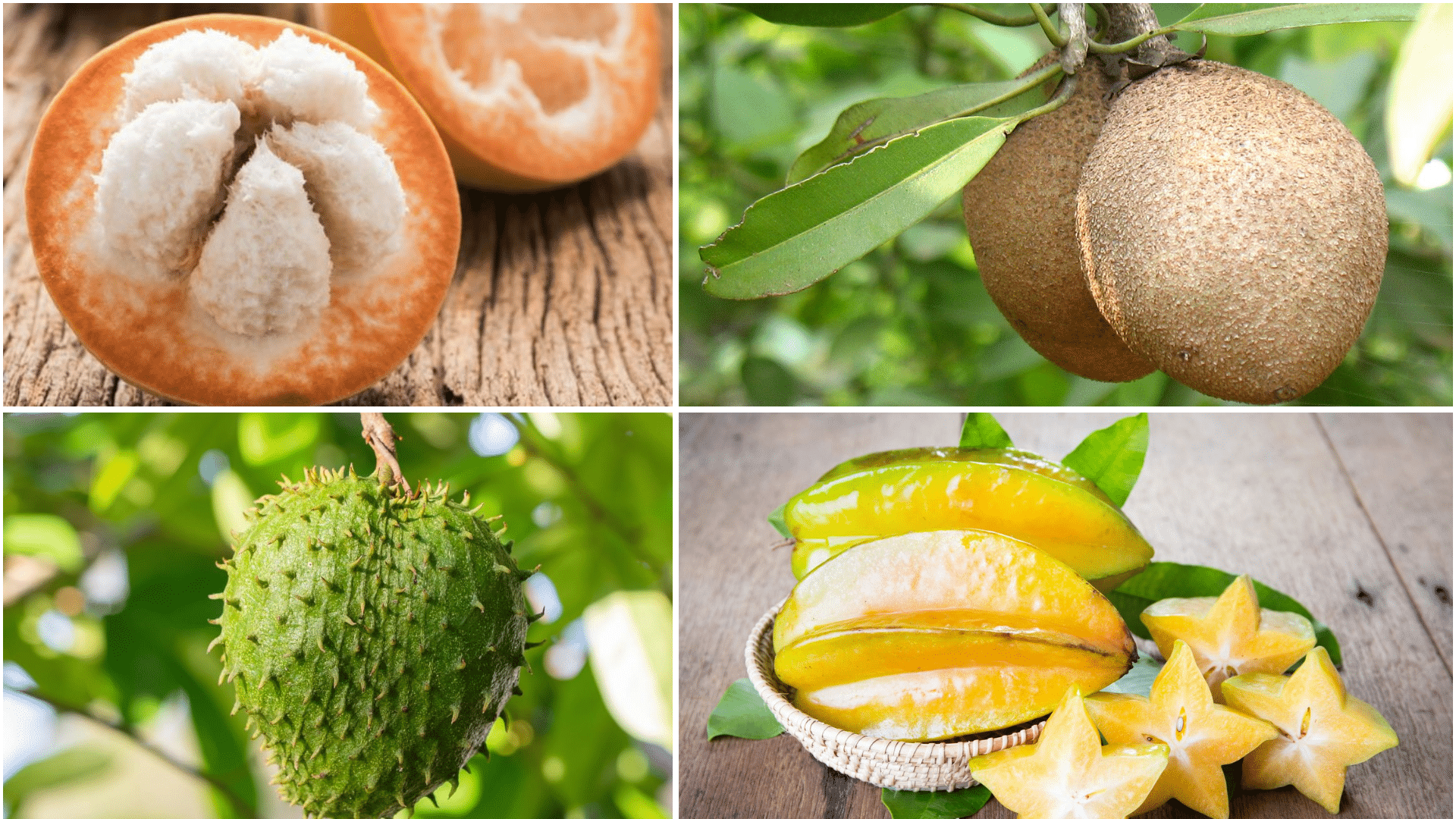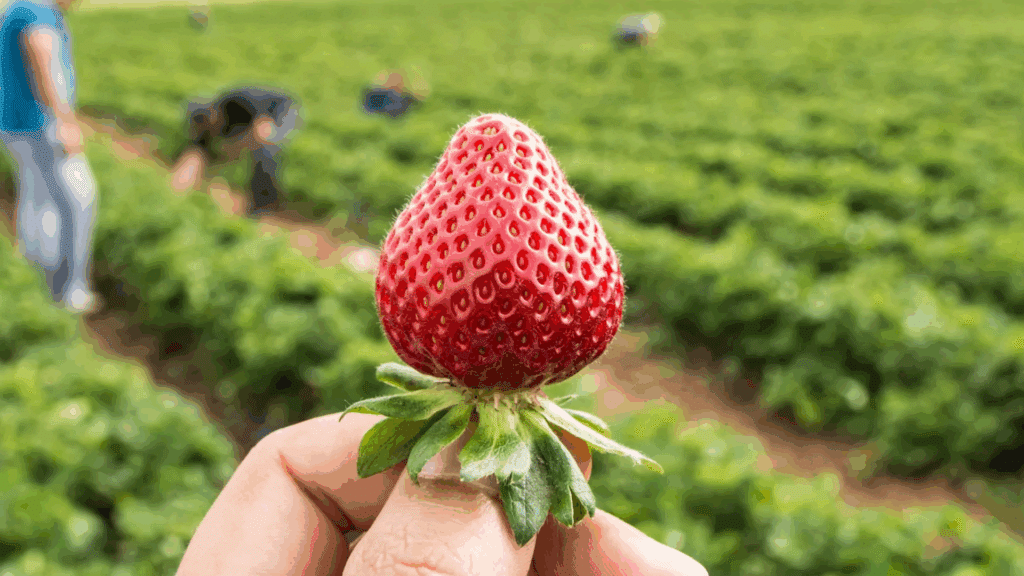Most people know about strawberries and sweet oranges. But what about starfruit or sugar apples? The letter S brings us an amazing collection of fruits from around the world. Some grow in tropical places, and some grow in cold mountain areas.
This blog covers different fruits that start with S. You’ll learn about common ones like strawberries and surprising ones like salmonberries. Each fruit has its origin, taste, and nutritional value. Some are sweet. Others are sour or tangy.
Let’s start with the first fruit on our list and work our way through all options.
Lesser-Known Fruits that Start with S

There are many lesser-known “S” fruits like salak (snake fruit), soursop, and santol that are native to specific regions and offer unique tastes and textures.
These fruits are gaining attention for their exotic flavors and nutritional benefits, but may be less familiar to the general public.
The following are some lesser-known fruits that start with s.
1. Saba Nut
Saba nut is the edible seed of the Malabar chestnut tree, eaten raw or roasted, with a mildly sweet, nutty flavor.
- Origin: Native to Central and South America.
- Availability Season: Late summer to autumn.
- Taste: Mildly sweet, nutty, soft when cooked.
- Nutritional Value: Contains protein, healthy fats, fiber, and some minerals.
2. Saguaro Fruit
Saguaro fruit is a red, oval fruit from the saguaro cactus, with sweet, seedy pulp, traditionally harvested by indigenous peoples.
- Origin: Native to the Sonoran Desert, southwestern United States, and Mexico.
- Availability Season: Early summer.
- Taste: Sweet, mildly tangy, with crunchy seeds.
- Nutritional Value: Provides vitamin C, fiber, natural sugars, and some minerals.
3. Salal Berry
Salal berry is a small, dark purple berry with sweet, earthy flavor, eaten fresh or dried, and used in jams or desserts.
- Origin: Native to the Pacific Northwest of North America.
- Availability Season: Summer to early autumn.
- Taste: Sweet, earthy, slightly tart, with a unique flavor.
- Nutritional Value: Contains vitamin C, fiber, manganese, and antioxidants.
4. Sand Cherry
Sand cherry is a small, dark purple or black fruit with sweet-tart flavor, eaten fresh, in jellies, or for wildlife food.
- Origin: Native to North America, especially the Great Plains and Rocky Mountains.
- Availability Season: Late summer.
- Taste: Sweet-tart, juicy, with a cherry-like flavor.
- Nutritional Value: Contains vitamin C, vitamin A, fiber, and antioxidants.
5. Shikuwasa
Shikuwasa is a small, green citrus fruit from Okinawa, Japan, with tart, aromatic juice, used in drinks, sauces, and desserts.
- Origin: Native to Okinawa and Taiwan.
- Availability Season: Late summer to autumn.
- Taste: Tart, aromatic, citrusy, with a refreshing acidity.
- Nutritional Value: High in vitamin C, flavonoids, antioxidants, and some potassium.
6. Saramuyo
Saramuyo, also called sugar apple, is a green, scaly fruit with creamy, sweet, custard-like pulp, enjoyed fresh or in desserts.
- Origin: Native to the Caribbean, South America, Mexico, and parts of Asia.
- Availability Season: Late spring to early autumn, depending on the region.
- Taste: Sweet, creamy, custard-like, with a slightly acidic undertone and pleasant aroma.
- Nutritional Value: High in vitamin C, manganese, thiamine, vitamin B6, energy, and dietary fiber.
7. Satsuma Plum
Satsuma plum is a medium-sized, red-skinned stone fruit with juicy, sweet-tart flesh, often eaten fresh or used in preserves.
- Origin: Native to China, widely cultivated in Japan and the United States.
- Availability Season: Summer, typically June to August.
- Taste: Sweet-tart, juicy, with a rich plum flavor and subtle floral notes.
- Nutritional Value: Good source of vitamin C, vitamin K, fiber, potassium, and antioxidants.
8. Seagrape
Seagrape is a cluster-forming, round, purple fruit found on coastal plants, with a mildly sweet, musky flavor, eaten fresh or made into jelly.
- Origin: Native to tropical Americas and the Caribbean.
- Availability Season: Late summer to early autumn.
- Taste: Mildly sweet, musky, slightly acidic, with a grape-like flavor.
- Nutritional Value: Contains vitamin C, calcium, fiber, and some antioxidants.
9. Senna Fruit
Senna fruit is a small, pod-like fruit from the senna plant, traditionally used for its medicinal properties, especially as a natural laxative.
- Origin: Native to tropical Africa, widely grown in India and the Middle East.
- Availability Season: Late summer to autumn.
- Taste: Slightly bitter, earthy, not typically consumed for flavor.
- Nutritional Value: Contains sennosides, fiber, and some minerals; primarily valued for its medicinal effects.
10. Service Tree Fruit
Service tree fruit is a small, brownish pome, similar to a medlar, with sweet, soft flesh when bletted, used in jams and liqueurs.
- Origin: Native to southern and central Europe, western Asia, and northern Africa.
- Availability Season: Autumn, typically September to November.
- Taste: Sweet, slightly tart, with a flavor reminiscent of dates and apples when fully ripe.
- Nutritional Value: Contains vitamin C, fiber, and some antioxidants.
11. Shonan Gold
Shonan Gold is a bright yellow, hybrid citrus fruit from Japan, with juicy, sweet, and slightly tangy flesh, eaten fresh or juiced.
- Origin: Developed in Kanagawa Prefecture, Japan.
- Availability Season: Spring, mainly March to May.
- Taste: Sweet, mildly tangy, fragrant, with a refreshing citrus flavor.
- Nutritional Value: High in vitamin C, some vitamin A, potassium, and fiber.
12. Sierra Plum
Sierra plum is a small, red or purple wild plum with tart, juicy flesh, eaten fresh or used in jams and preserves.
- Origin: Native to western North America, especially California and Oregon.
- Availability Season: Summer, June to August.
- Taste: Tart, juicy, with a robust wild plum flavor.
- Nutritional Value: Contains vitamin C, vitamin K, fiber, and antioxidants.
13. Silkworm Fruit
Silkworm fruit, also known as mulberry, is a long, dark purple berry with sweet-tart, juicy flesh, consumed fresh or in desserts.
- Origin: Native to Asia, widely cultivated worldwide.
- Availability Season: Late spring to early summer.
- Taste: Sweet-tart, juicy, with a mild berry flavor.
- Nutritional Value: High in vitamin C, iron, vitamin K, fiber, and antioxidants.
14. Silverberry
Silverberry is a small, oval fruit with silvery skin and sweet, fragrant flesh, eaten fresh or used in jams and traditional remedies.
- Origin: Native to Asia and North America, especially in temperate regions.
- Availability Season: Autumn, September to November.
- Taste: Sweet, aromatic, sometimes slightly astringent.
- Nutritional Value: Contains vitamin C, fiber, flavonoids, and antioxidants.
15. Simonetta Fruit
Simonetta fruit is a rare or lesser-known fruit, described as small, sweet, and aromatic, with limited information available about its broader uses.
- Origin: Specific origin unclear, possibly cultivated in select regions.
- Availability Season: Not well-documented; likely seasonal based on local climate.
- Taste: Sweet, aromatic, with a pleasant, unique flavor.
- Nutritional Value: Likely contains vitamin C, fiber, and some antioxidants, based on similar fruits.
16. Sloe Berry
Sloe berry is a small, dark purple-black fruit from the blackthorn bush, used to make sloe gin, jams, and preserves.
- Origin: Native to Europe, western Asia, and northwest Africa.
- Availability Season: Autumn, typically September to November.
- Taste: Very tart, astringent, slightly bitter when raw; mellows when cooked or infused.
- Nutritional Value: Contains vitamin C, antioxidants, fiber, and some minerals.
17. Snowberry
Snowberry is a small, round, white berry from a hardy shrub, admired for its ornamental value but toxic if consumed by humans.
- Origin: Native to North America; naturalized in Britain and other temperate regions.
- Availability Season: Late summer through winter; berries persist on branches.
- Taste: Not edible; described as distasteful and toxic, with a wintergreen-like flavor.
- Nutritional Value: Contains saponins with antioxidant and antimicrobial properties; toxic to humans if ingested.
18. Soapberry
Soapberry is a small, yellowish, berry-like drupe containing saponins, used as a natural soap and for medicinal purposes in various cultures.
- Origin: Native to tropical and subtropical regions, including the Himalayas, Asia, and the Americas.
- Availability Season: Late summer to autumn, depending on species.
- Taste: Not consumed for food; bitter and soapy due to high saponin content.
- Nutritional Value: Contains saponins (natural detergents), some antioxidants, and mild antimicrobial compounds; not eaten as fruit.
19. Soft-Shell Fruit
Soft-shell fruit refers to fruits with thin, easily penetrable shells, such as certain nuts or drupes, valued for their edible kernels.
- Origin: Varies widely; includes species from Asia, the Americas, and the Mediterranean.
- Availability Season: Depends on the specific fruit species.
- Taste: Generally mild, nutty, or sweet, depending on the fruit.
- Nutritional Value: Typically high in healthy fats, protein, vitamins, and minerals.
20. Solomon’s Seal Fruit
Solomon’s seal fruit is a small, blue-black berry from a woodland plant, considered toxic to humans but eaten by some wildlife.
- Origin: Native to temperate regions of the Northern Hemisphere, especially North America, Europe, and Asia.
- Availability Season: Late summer to early autumn.
- Taste: Not edible for humans; mildly sweet but toxic.
- Nutritional Value: Not consumed by humans; contains compounds that can cause digestive upset.
21. Sour Cherry
Sour cherry is a small, bright red fruit with tart, juicy flesh, used in pies, preserves, and juices for its refreshing acidity.
- Origin: Native to Europe and southwest Asia.
- Availability Season: Early to mid-summer.
- Taste: Tart, tangy, juicy, with a pronounced cherry flavor.
- Nutritional Value: High in vitamin C, vitamin A, antioxidants, and fiber.
22. Sour Plum
Sour plum is a small, green to purple fruit with tart, juicy flesh, commonly eaten fresh, pickled, or used in sauces.
- Origin: Native to Asia, the Mediterranean, and parts of Africa.
- Availability Season: Spring to early summer.
- Taste: Very tart, tangy, sometimes slightly sweet when fully ripe.
- Nutritional Value: Contains vitamin C, potassium, fiber, and antioxidants.
23. Spanish Chestnut
Spanish chestnut is a large, brown, edible nut encased in a spiny husk, enjoyed roasted or used in sweet and savory dishes.
- Origin: Native to southern Europe and Asia Minor.
- Availability Season: Autumn, typically October to December.
- Taste: Sweet, nutty, starchy, with a creamy texture when cooked.
- Nutritional Value: High in carbohydrates, vitamin C, fiber, potassium, and some B vitamins.
24. Spear Fruit
Spear fruit is a term sometimes used for elongated, pointed fruits, but specific examples and details vary depending on local usage and species.
- Origin: Varies by specific fruit species.
- Availability Season: Depends on the fruit in question.
- Taste: Varies; often mild, sweet, or tangy.
- Nutritional Value: Typically contains vitamins, minerals, and fiber, depending on the species.
Common Fruits that Start with S

Many popular and widely consumed fruits begin with the letter “S,” such as strawberries, starfruit, and satsumas. These fruits are easily found in markets worldwide and are often enjoyed fresh or used in various recipes due to their sweet and tangy flavors.
The following are some common fruits that start with s.
25. Strawberry
26. Starfruit (Carambola)
27. Sapodilla
28. Soursop
29. Sweet Cherry
30. Sweet Lime
31. Sugar Apple (Sweetsop)
32. Salak (Snake Fruit)
33. Santol
34. Sea Buckthorn
35. Saskatoon Berry
36. Strawberry Guava
37. Surinam Cherry
38. Sugarcane
39. Sweet Orange
40. Sunberry
41. Sweet Melon
42. Spanish Lime (Mamoncillo)
43. Sugar Pear
44. Sweet Lemon
45. Serviceberry
46. Shaddock (Pomelo)
47. Satsuma
48. Sweet Cherry Tomato
49. Strawberry Tree Fruit (Arbutus)
50. Sapote
51. Sweet Granadilla
52. Sweet Tamarind
53. Scarlet Runner Bean
54. Strawberry Seville Orange
55. Sweet Persimmon
56. Sweet Almond
57. Sweet Blackberry
58. Sweet Fig
59. Sweet Mulberry
Health Benefits of Some Fruits that Start with S
Fruits that start with S are rich in vitamins, antioxidants, fiber, and minerals that support various aspects of health, including blood pressure regulation, diabetes management, immune support, and anti-inflammatory effects.
- High Blood Pressure: Strawberry, Starfruit, and Salah are rich in potassium and antioxidants; they fruits help regulate blood pressure and support heart health.
- Diabetes: Strawberry, Sapodilla, and Salak have a low glycemic index and high fiber content, and help manage blood sugar levels.
- Heart Disease: Strawberry, Serviceberry, and Saskatoon Berry are high in anthocyanins and fiber; these fruits support cardiovascular health.
- Digestive Issues: Sapodilla, Starfruit, Sugar Apple are high in fiber content, aid digestion, and promote gut health.
- Immune Support: Strawberry, Soursop, and Surinam Cherry are rich in vitamin C and antioxidants; these fruits boost immune function.
- Inflammation: Strawberry, Saskatoon Berry, and Surinam Cherry are rich in antioxidants and flavonoids that help reduce inflammation.
- Eye Health: Strawberry, Serviceberry, and Surinam Cherry are rich in vitamin A and antioxidants, supporting eye health.
- Skin Health: Strawberry, Surinam Cherry, and Soursop contain vitamin C and other antioxidants that promote healthy skin and collagen production.
Wrapping It Up
From common strawberries to exotic soursops, each fruits that start with S brings something special to the table. Some are perfect for snacks. Others work best in smoothies or desserts.
The next time you visit a grocery store or farmers market, look for these fruits that start with S. Try something new. Your taste buds might thank you for it. Maybe start with a starfruit or grab some fresh strawberries.
Remember, eating different fruits gives your body various nutrients.
So why not add a few more S fruits to your weekly shopping list?


















